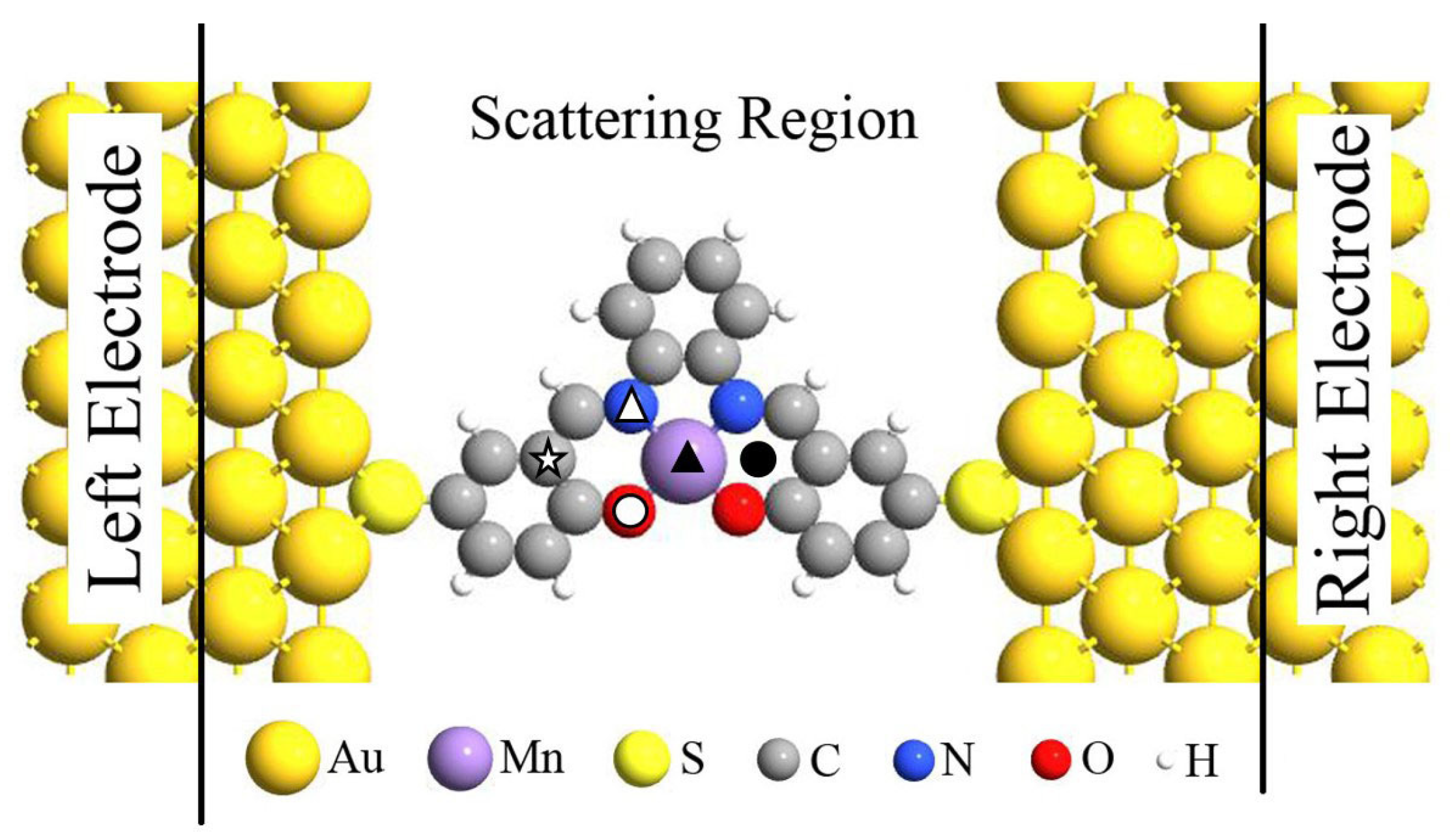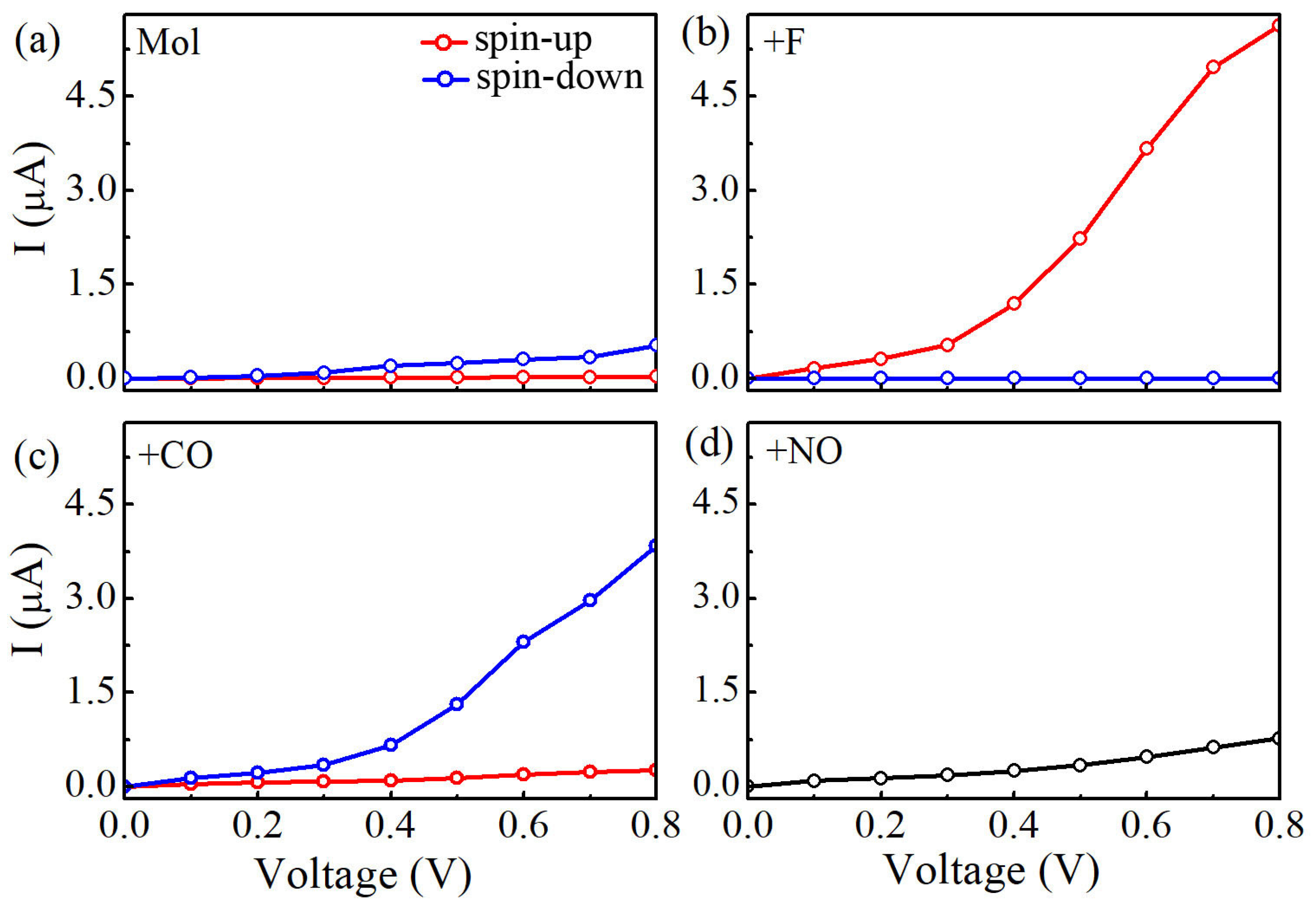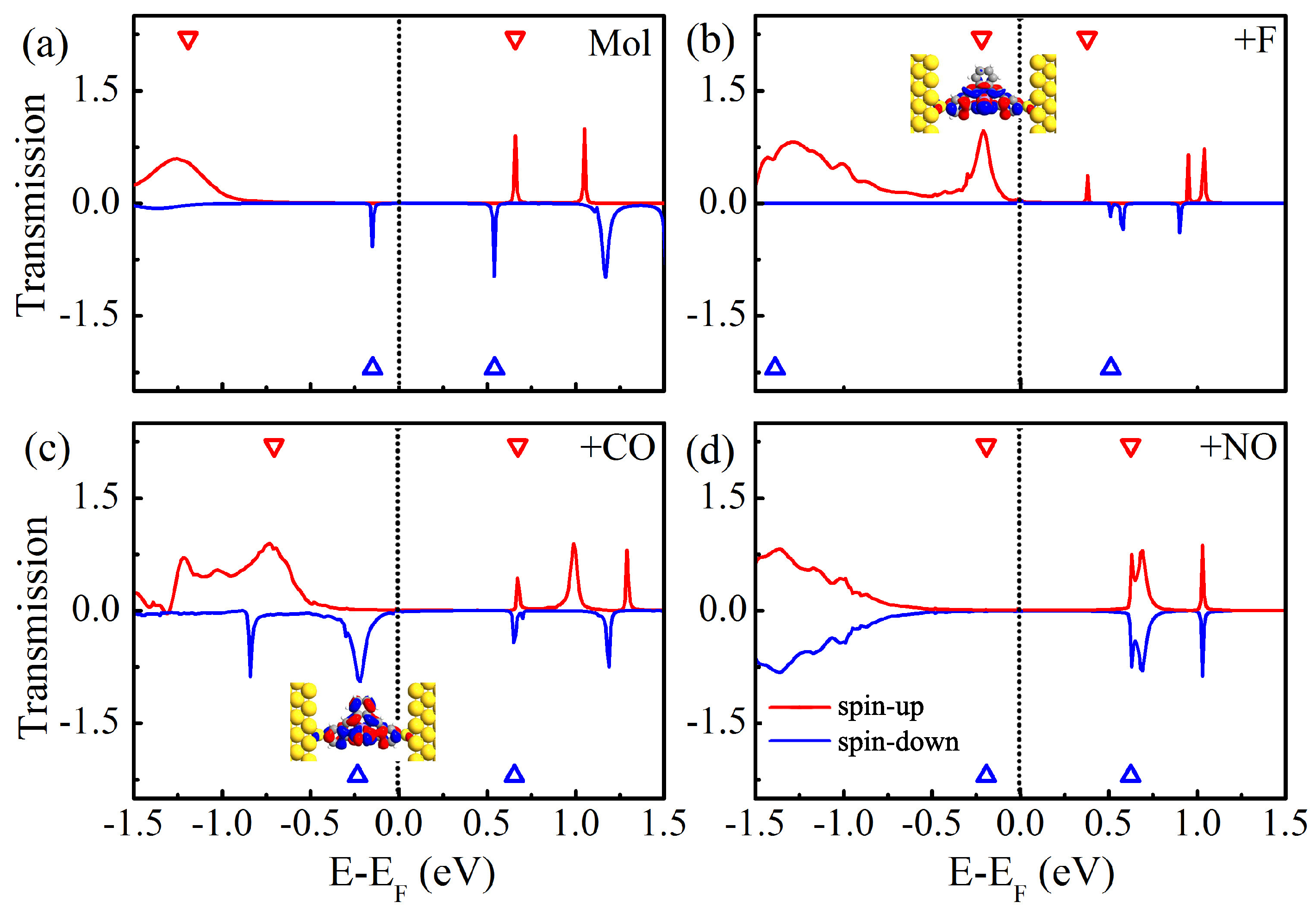Spin-Transport Tuning of Individual Magnetic Mn-Salophen Molecule via Chemical Adsorption
Abstract
1. Introduction
2. Computational Parameters and Method
3. Results and Discussion
4. Conclusions
Author Contributions
Funding
Acknowledgments
Conflicts of Interest
References
- Sanvito, S. Molecular spintronics. Chem. Soc. Rev. 2011, 40, 3336–3355. [Google Scholar] [CrossRef]
- Aravena, D.; Ruiz, E. Coherent transport through spin-crossover single molecules. J. Am. Chem. Soc. 2012, 134, 777–779. [Google Scholar] [CrossRef] [PubMed]
- Wagner, S.; Kisslinger, F.; Ballmann, S.; Schramm, F.; Chandrasekar, R.; Bodenstein, T.; Fuhr, O.; Secker, D.; Fink, K.; Ruben, M.; et al. Switching of a coupled spin pair in a single-molecule junction. Nat. Nanotechnol. 2013, 8, 575–579. [Google Scholar] [CrossRef]
- Zhang, J.L.; Zhong, J.Q.; Lin, J.D.; Hu, W.P.; Wu, K.; Xu, G.Q.; Wee, A.T.S.; Chen, W. Towards single molecule switches. Chem. Soc. Rev. 2015, 44, 2998–3022. [Google Scholar] [CrossRef]
- Xiang, D.; Wang, X.L.; Jia, C.C.; Lee, T.; Guo, X.F. Molecular-scale electronic: From concept to function. Chem. Rev. 2016, 116, 4318–4440. [Google Scholar] [CrossRef]
- Bogani, L.; Wernsdorfer, W. Molecular spintronics using single-molecules magnets. Nat. Mater. 2008, 7, 179–186. [Google Scholar] [CrossRef]
- Schmaus, S.; Bagres, A.; Nahas, Y.; Yamada, T.K.; Bork, A.; Bowen, M.; Beaurepaire, E.; Evers, F.; Wulfhekel, W. Giant magnetoresistance through a single molecule. Nat. Nanotechnol. 2011, 6, 185–189. [Google Scholar] [CrossRef]
- Mannini, M.; Pineider, F.; Saincatavit, P.; Danieli, C.; Otero, E.; Sciancalepore, C.; Talarico, A.M.; Arrio, M.A.; Cornia, A.; Gatteschi, D.; et al. Magnetic memory of a single-molecule quantum magnet wired to a gold surface. Nat. Mater. 2009, 8, 194–197. [Google Scholar] [CrossRef] [PubMed]
- Thies, S.; Sell, H.; Schütt, C.; Bornholdt, C.; Näther, C.; Tuczek, F.; Herges, R. Light-induced spin change by photodissociable external ligands: A new principle for magnetic switching of molecules. J. Am. Chem. Soc. 2011, 133, 16243–16250. [Google Scholar] [CrossRef] [PubMed]
- Pedersen, K.S.; Bendix, J.; Clérac, R. Single-molecule magnet engineering building-block approaches. Chem. Commun. 2014, 50, 4396–4415. [Google Scholar] [CrossRef] [PubMed]
- Zou, D.Q.; Zhao, W.K.; Cui, B.; Li, D.M.; Liu, D.S. Adsorption of gas molecules on a manganese phthalocyanine molecular device and its possibility as a gas sensor. Phys. Chem. Chem. Phys. 2018, 20, 2048–2056. [Google Scholar] [CrossRef] [PubMed]
- Stróżechka, A.; Soriano, M.; Pascual, J.I.; Palacios, J.J. Reversible change of the spin state in a manganese phthalocyanine by coordination of CO molecule. Phys. Rev. Lett. 2012, 109, 147202. [Google Scholar] [CrossRef] [PubMed]
- Liu, L.; Yang, K.; Jiang, B.; Song, B.; Xiao, W.; Li, L.; Zhou, H.; Wang, Y.; Du, S.; Ouyang, M.; et al. Reversible sinlge spin control of individual magnetic molecule by hydrogen atom adsorption. Sci. Rep. 2013, 3, 1210. [Google Scholar] [CrossRef] [PubMed]
- Ghosh, D.; Parida, P.; Pati, S.K. Spin-state switching of manganese porphyrin by conformational modification. J. Phys. Chem. C 2016, 120, 3625–3634. [Google Scholar] [CrossRef]
- Prasongkit, J.; Rocha, A.R. Quantum interference effects in biphenyl dithiol for gas detection. RSC Adv. 2016, 6, 59299–59304. [Google Scholar] [CrossRef]
- Omiya, T.; Poli, P.; Arnolds, H.; Raval, R.; Persson, M.; Kim, Y. Desorption of CO from individual ruthenium porphyrin molecules on a copper surface via an inelastic tunnelling process. Chem. Commun. 2017, 53, 6148–6151. [Google Scholar] [CrossRef]
- Wäckerlin, C.; Chylarecka, D.; Kleibert, A.; Müller, K.; Lacovita, C.; Nolting, F.; Jung, T.A.; Ballav, N. Controlling spins in adsorbed molecules by a chemical switch. Nat. Commun. 2010, 61, 1. [Google Scholar] [CrossRef]
- Kondo, H.; Nara, J.; Ohno, T. Possibility of gas sensor using electronic transport properties of iron-porphyrin molecular junction system. J. Phys. Chem. C 2011, 115, 6886–6892. [Google Scholar] [CrossRef]
- Hao, H.; Zheng, X.H.; Dai, Z.X.; Zeng, Z. Spin-filtering transport and switching effect of MnCu sinlge-molecule magnet. Appl. Phys. Lett. 2010, 96, 192112. [Google Scholar] [CrossRef]
- Hao, H.; Zheng, X.H.; Dai, Z.X.; Zeng, Z. Gate-indueced switching in sinlge-molecule magnet MnCu. J. Appl. Phys. 2011, 110, 023702. [Google Scholar] [CrossRef]
- Huang, J.; Xie, R.; Wang, W.Y.; Li, Q.X.; Yang, J.L. Coherent transport through spin-crossover magnet Fe2 complexes. Nanoscale 2016, 8, 609–616. [Google Scholar] [CrossRef] [PubMed]
- Yergeshbayeva, S.; Hrudka, J.J.; Lengyel, J.; Erkasov, R.; Stoian, S.A.; Dragulescu-Andrasi, A.; Shatruk, M. Heteroleptic FeII complexes with N4S2 coordination as a platform for designing spin-crossover materials. Inorg. Chem. 2017, 56, 11096–11103. [Google Scholar] [CrossRef] [PubMed]
- Du, M.L.; Hu, Y.J.; Huang, J.; Li, Q.X. Electronic transport properties of spin-crossover magnet Fe(II)-N4S2 complexes. Chin. J. Chem. Phys. 2018, 31, 33–38. [Google Scholar] [CrossRef]
- Shen, X.; Sun, L.L.; Yi, Z.L.; Benassi, E.; Zhang, R.X.; Shen, Z.Y.; Sanvito, S.; Hou, S.M. Spin transport properties of 3d transition metal(II) phthalocyanines in contact with single-walled carbon nanotube electrodes. Phys. Chem. Chem. Phys. 2010, 12, 10805–10811. [Google Scholar] [CrossRef] [PubMed]
- Shen, X.; Sun, L.; Benassi, E.; Shen, Z.Y.; Zhao, X.Y.; Sanvito, S.; Hou, S.M. Spin filter effect of manganese phthalocyanine contacted with sinlge-walled carbon nanotube electroes. J. Chem. Phys. 2010, 132, 054703. [Google Scholar] [CrossRef] [PubMed]
- Huang, J.; Li, Q.X.; Xu, K.; Su, H.B.; Yang, J.L. Electronic, magnetic, and transport properties of F-COT clusters: A theoretical study. J. Phys. Chem. C 2010, 114, 11946–11950. [Google Scholar] [CrossRef]
- Xu, K.; Huang, J.; Lei, S.L.; Su, H.B.; Boey, F.Y.C.; Li, Q.X.; Yang, J.L. Efficient organometallic spin filter based on Europium-cyclooctatetraene wire. J. Chem. Phys. 2009, 131, 104704. [Google Scholar] [CrossRef]
- Tong, J.H.; Zhang, Y.; Li, Z.; Xia, C. Highly effective catalysts of natural polymer supported Salophen Mn(III) Complexes for aerobic oxidation of cyclohexene. J. Mol. Catal. A-Chem. 2006, 249, 47–52. [Google Scholar] [CrossRef]
- Cort, A.D.; De Bernardin, P.; Forte, G.; Mihan, F.Y. Metal-salophen-bsed receptors for anions. Chem. Soc. Rev. 2010, 39, 3863–3874. [Google Scholar] [CrossRef]
- Peng, J.; Zhou, W.X.; Chen, K.Q. High-efficiency spin filtering in salophen-based molecular junctions modulated with different transition metal atoms. Phys. Lett. A 2014, 378, 3126–3130. [Google Scholar] [CrossRef]
- Soler, J.M.; Artacho, E.; Gale, J.D.; García, A.; Junquera, J.; Ordejón, P.; Sánchez-Portal, D. The SIESTA method for ab initio order-N materials simulation. J. Phys. Condes. Matter 2002, 14, 2745–2779. [Google Scholar] [CrossRef]
- Taylor, J.; Guo, H.; Wang, J. Ab initio modeling of quantum transport properties of molecular electronic devices. Phys. Rev. B 2001, 63, 245407. [Google Scholar] [CrossRef]
- Brandbyge, M.; Mozos, J.L.; Ordejón, P.; Taylor, J.; Stokbro, K. Density-functional method for nonequilbirum electron transport. Phys. Rev. B 2002, 65, 165401. [Google Scholar] [CrossRef]
- Wu, X.J.; Li, Q.X.; Huang, J.; Yang, J.L. Nonequilibrium electronic transport of 4,4-bipyridine molecular junction. J. Chem. Phys. 2005, 123, 184712. [Google Scholar] [CrossRef] [PubMed]
- Cui, P.; Zhang, Q.; Zhu, H.B.; Li, X.X.; Wang, W.Y.; Li, Q.X.; Zeng, C.G.; Zhang, Z.Y. Carbon tetragons as definitive spin switches in narrow zigzag graphene nanoribbons. Phys. Rev. Lett. 2016, 116, 026802. [Google Scholar] [CrossRef] [PubMed]
- Huang, J.; Wang, W.Y.; Yang, S.F.; Li, Q.X.; Yang, J.L. Efficient spin filter based on FeN4 complexes between carbon nanotube electrodes. Nanotechnology 2012, 23, 255202. [Google Scholar] [CrossRef] [PubMed]
- Huang, J.; Wang, W.Y.; Yang, S.F.; Su, H.B.; Li, Q.X.; Yang, J.L. A theoretical study of spin-polarized transport properties of planar four-coordinate Fe complexes. Chem. Phys. Lett. 2012, 539–540, 102–106. [Google Scholar] [CrossRef]
- Xu, K.; Huang, J.; Guan, Z.Y.; Li, Q.X.; Yang, J.L. Transport spin polarization of magnetic C28 molecular junctions. Chem. Phys. Lett. 2012, 535, 111–115. [Google Scholar] [CrossRef]
- Bhattacharjee, S.; Brena, B.; Banerjee, R.; Wende, H.; Eriksson, O.; Sanyal, B. Electronic structure of Co-phthalocyanine calculated by GGA+U and hybrid functional methods. Chem. Phys. 2010, 277, 96–99. [Google Scholar] [CrossRef]
- Brena, B.; Puglia, C.; de Simone, M.; Coreno, M.; Tarafder, K.; Feyer, V.; Banerjee, R.; Göthelid, E.; Sanyal, B.; Oppeneer, P.M.; Eriksson, O. Valence-band electronic structure of iron phthalocyanine: An experimental and theoretical photoelectron spectroscopy study. J. Chem. Phys. 2011, 134, 074312. [Google Scholar] [CrossRef]
Sample Availability: Samples of the compounds are not available from the authors. |





| Position | Mn-Site | N-Site | C-Site | O-Site | Hollow Site |
|---|---|---|---|---|---|
| F case | 0.0 | 2.08 | 2.33 | 2.34 | 2.12 |
| CO case | 0.0 | 1.17 | 1.37 | 1.41 | 1.18 |
| NO case | 0.0 | 3.35 | 3.84 | 3.72 | 3.31 |
| Junction | Mn-Salophen | +F | +CO | +NO |
|---|---|---|---|---|
| spin-up | 9.3 × 10 | 6.8 × 10 | 1.4 × 10 | 4.9 × 10 |
| spin-down | 2.1 × 10 | 5.7 × 10 | 5.4 × 10 | 4.9 × 10 |
© 2019 by the authors. Licensee MDPI, Basel, Switzerland. This article is an open access article distributed under the terms and conditions of the Creative Commons Attribution (CC BY) license (http://creativecommons.org/licenses/by/4.0/).
Share and Cite
Li, F.; Huang, J.; Wang, J.; Li, Q. Spin-Transport Tuning of Individual Magnetic Mn-Salophen Molecule via Chemical Adsorption. Molecules 2019, 24, 1747. https://doi.org/10.3390/molecules24091747
Li F, Huang J, Wang J, Li Q. Spin-Transport Tuning of Individual Magnetic Mn-Salophen Molecule via Chemical Adsorption. Molecules. 2019; 24(9):1747. https://doi.org/10.3390/molecules24091747
Chicago/Turabian StyleLi, Feifei, Jing Huang, Jianing Wang, and Qunxiang Li. 2019. "Spin-Transport Tuning of Individual Magnetic Mn-Salophen Molecule via Chemical Adsorption" Molecules 24, no. 9: 1747. https://doi.org/10.3390/molecules24091747
APA StyleLi, F., Huang, J., Wang, J., & Li, Q. (2019). Spin-Transport Tuning of Individual Magnetic Mn-Salophen Molecule via Chemical Adsorption. Molecules, 24(9), 1747. https://doi.org/10.3390/molecules24091747






